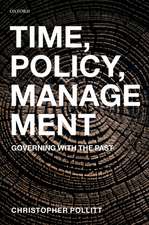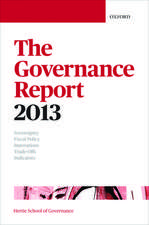Contemporary Policy Analysis
Autor Michael Mintromen Limba Engleză Paperback – 30 iun 2011
Contemporary Policy Analysis works from a project orientation, providing a thorough and nontechnical overview of the key concepts and analytical strategies employed by policy analysts. Opening with coverage of what policy analysts do, what governments do, and government policy objectives, the first section of the book then discusses how to manage policy projects, present policy advice, and perform ethical policy analysis. The second section presents a set of core analytical strategies, featuring chapters on the analysis of markets, market failure, government failure, comparative institutional analysis, cost-benefit analysis, implementation analysis, and--unique to this survey--gender analysis and race analysis. Each of these strategy chapters includes a step-by-step guide to performing the analysis, incorporating an example from the policy literature that follows the steps and shows how the strategy can illuminate current policy issues. In addition, the chapters are enhanced by exercises and suggestions for class projects and policy research seminars.
Preț: 774.62 lei
Preț vechi: 1061.12 lei
-27% Nou
Puncte Express: 1162
Preț estimativ în valută:
148.24€ • 154.20$ • 122.38£
148.24€ • 154.20$ • 122.38£
Carte disponibilă
Livrare economică 25 martie-08 aprilie
Preluare comenzi: 021 569.72.76
Specificații
ISBN-13: 9780199730964
ISBN-10: 0199730962
Pagini: 348
Dimensiuni: 155 x 231 x 20 mm
Greutate: 0.54 kg
Editura: Oxford University Press
ISBN-10: 0199730962
Pagini: 348
Dimensiuni: 155 x 231 x 20 mm
Greutate: 0.54 kg
Editura: Oxford University Press
Descriere
A groundbreaking interpretation of the field, Contemporary Policy Analysis offers a state-of-the art look at what policy analysts do and how they can make the world a better place. The book is an indispensable resource for experienced policy analysts and an ideal core text for upper-level undergraduate and first-year graduate courses in policy analysis. Contemporary Policy Analysis works from a project orientation, providing a thorough and nontechnical overview of the key concepts and analytical strategies employed by policy analysts. Opening with coverage of what policy analysts do, what governments do, and government policy objectives, the first section of the book then discusses how to manage policy projects, present policy advice, and perform ethical policy analysis. The second section presents a set of core analytical strategies, featuring chapters on the analysis of markets, market failure, government failure, comparative institutional analysis, cost-benefit analysis, implementation analysis, and--unique to this survey--gender analysis and race analysis. Each of these strategy chapters includes a step-by-step guide to performing the analysis, incorporating an example from the policy literature that follows the steps and shows how the strategy can illuminate current policy issues. In addition, the chapters are enhanced by exercises and suggestions for class projects and policy research seminars.
Cuprins
Preface 1. Introduction The Nature of Policy Analysis The Rise of Policy Analysis The Purpose and Organization of this Book Conclusion Exercises Further Reading OVERVIEW OF POLICY ANALYSIS 2. What Policy Analysts Do The Social Function of Policy Analysis Where Policy Analysts Are Employed How Policy Analysts Contribute to Public Decision Making Common Competencies and Attributes of Successful Policy Analysts Why Being a Policy Analyst Is an Appealing Career Choice Conclusion Exercises Invite a Guest to Class Further Reading 3. What Governments Do The Role of Government in Society Achieving Cooperation A Review of Government Policy Actions Market Making Taxes Subsidies Regulation Direct Service Supply Funding and Contracting Partnering and Facilitating Information and Social Marketing Frameworks and Strategies Summary Increasing Complexity Looking Ahead Exercises Further Reading 4. Objectives of Government Policy Actions Discussing Government Policy Action Promoting Human Flourishing Promoting Effective Institutions Promoting Efficiency Promoting Sustainability Advancing Human Rights Promoting Social Equity Problem Definition and Agenda Setting Working with Objectives, Goals, and Public Policies Conclusion Exercises Further Reading 5. Managing Policy Projects The Discipline of Project Management Project Initiation Project Planning Project Execution and Control Project Closure Developing a Policy Project Proposal A Project Summary A List of Project Objectives A List of Project Deliverables A Project Task List A Preliminary Time Budget A Project Timeline Biographical Statements A Project Budget A Risk Assessment Transitioning to Project Execution and Control Constructing Progress Reports Managing Your Time Make "To Do" Lists Prioritize among Activities Batch Routine Tasks Think about Opportunity Costs Think in Marginalist Terms Take Care of Relations with Others Manage Your Downtime Working with Policy Literature Conclusion Exercises The Class Project Further Reading 6. Presenting Policy Advice Clarifying Audience Needs Structuring a Policy Report Abstract or Executive Summary Table of Contents Introduction Background Analytical Strategy Analysis and Findings Discussion Policy Recommendations Conclusion Other Items Effective Presentation of Evidence Reflecting on the Contribution The Sign-Off Developing Presentations and Oral Briefings The Importance of Creativity Conclusion Exercises Invite a Guest to Class Further Reading 7. Doing Ethical Policy Analysis Policy Analysis and Ethical Practice Ethical Principles for Policy Analysts Integrity Competence Responsibility Respect Concern Doing Ethical Policy Analysis Ethical Problem Definition Ethical Construction of Alternatives Ethical Selection of Criteria Ethical Prediction of Outcomes Ethical Analysis of Trade-Offs Ethical Reporting Practices Conclusion Exercises Invite a Guest to Class Further Reading ANALYTICAL STRATEGIES 8. Introduction to the Analytical Strategies Policy Analysts in the Policy-Making Process The Analytical Strategy Chapters Chapter 9: Analysis of Markets Chapter 10: Analysis of Market Failure Chapter 11: Analysis of Government Failure Chapter 12: Comparative Institutional Analysis Chapter 13: Cost-Benefit Analysis Chapter 14: Gender Analysis Chapter 15: Race Analysis Chapter 16: Implementation Analysis Use of Applied Examples The Analytical Strategies and General Steps in Policy Analysis When to Apply Each Analytical Strategy Conclusion 9. Analysis of Markets An Introduction to Market Analysis Consumer Choice and the Demand Side of the Market Firm Behavior and the Supply Side of the Market Equilibrium in Markets Comparative Static Equilibrium Analysis Price Signaling and Interconnected Markets Assumptions of the Market Model Revisited Using Market Analysis as an Analytical Framework Steps in Market Analysis Step 1: Identify the phenomenon of interest. Step 2: Consider the behavior of consumers and producers. Step 3: Think in terms of comparative statics equilibrium analysis. Step 4: Collect and analyze the relevant information. Step 5: Draw implications for government action. An Applied Example Step 1: Identify the phenomenon of interest. Step 2: Consider the behavior of consumers and producers. Step 3: Think in terms of comparative statics equilibrium analysis. Step 4: Collect and analyze the relevant information. Step 5: Draw implications for government action. Advice for Analytical Practice Analysis of Markets and Other Analytical Strategies Chapter Content Review: A Self-Test Exercises The Policy Research Seminar Further Reading 10. Analysis of Market Failure An Overview of Market Failure Information Asymmetries Rectifying Information Asymmetries Positive Externalities Rectifying Positive Externalities Negative Externalities Rectifying Negative Externalities Public Goods: Common Pool Resources Rectifying Problems with Common Pool Resources Pure Public Goods: The Need for Collective Provision Arranging Collective Provision Natural Monopolies and How They Can Be Managed Social Equity Concerns and How They Can Be Addressed Using Market Failure as an Analytical Framework Steps in the Analysis of Market Failure Step 1: Specify the good or service of interest. Step 2: Identify the consumers and producers and the location of their transactions. Step 3: Using the tools of market analysis, construct a simple model of how an efficient market would allocate this good or service. Step 4: State the market failure that you believe is present in this context. Step 5: Analyze the actions of consumers and producers and how those actions contribute to market failure. Step 6: Estimate the financial implications of the market failure, and note any other salient impacts. Step 7: Identify efforts made by consumers, producers, and any other nongovernmental actors to address the market failure. Step 8: Suggest how government use of policy instruments could potentially address the market failure. An Applied Example Step 1: Specify the good or service of interest. Step 2: Identify the consumers and producers and the location of their transactions. Step 3: Using the tools of market analysis, construct a simple model of how an efficient market would allocate this good or service. Step 4: State the market failure that you believe is present in this context. Step 5: Analyze the actions of consumers and producers and how those actions contribute to market failure. Step 6: Estimate the financial implications of the market failure and note any other salient impacts. Step 7: Identify efforts made by consumers, producers, and any other nongovernmental actors to address the market failure. Step 8: Suggest how government use of policy instruments could potentially address the market failure. Advice for Analytical Practice Market Failure and Other Analytical Strategies Exercises The Policy Research Seminar Further Reading 11. Analysis of Government Failure An Overview of Government Failure and Its Analysis Government and Coordination Problems Political Control Provider Capture Perverse Incentives Goal Displacement Institutional Inertia Using Government Failure as an Analytical Framework Steps in the Analysis of Government Failure Step 1. Define the area of policy interest. Step 2. Determine the objectives of government action. Step 3. Note the nature of information and coordination problems that can arise through reliance on decentralized, private decision making. Step 4. Contrast the current or favored government actions with possible alternatives. Step 5. Identify opportunities for undue political interference in program management. Step 6. Identify opportunities for provider capture. Step 7. Identify perverse incentives and unintended outcomes. Step 8. Propose changes in policy design to reduce observed government failure. Step 9. Consider ways that reliance on government action could be reduced over time. An Applied Example Step 1. Define the area of policy interest. Step 2. Determine the objectives of government action. Step 3. Note the nature of information and coordination problems that can arise through reliance on decentralized, private decision making. Step 4. Contrast the current or favored government actions with possible alternatives. Step 5. Identify opportunities for undue political interference in program management. Step 6. Identify opportunities for provider capture. Step 7. Identify perverse incentives and unintended outcomes. Step 8. Propose changes in policy design to reduce observed government failure. Step 9. Consider ways that reliance on government action could be reduced over time. Advice for Analytical Practice Analysis of Government Failure and Other Analytical Strategies Exercises The Policy Research Seminar Further Reading 12. Comparative Institutional Analysis An Overview of Comparative Institutional Analysis Using Comparative Institutional Analysis as an Analytical Framework Steps in Comparative Institutional Analysis Step 1: Select and refine the analytical questions. Step 2: Develop a research design, and select cases. Step 3: Collect and analyze the relevant information. Step 4: Isolate the relationships between institutional choice and observed outcomes. Step 5: Present your findings, and make recommendations. An Applied Example Step 1: Select and refine the analytical questions. Step 2: Develop a research design, and select cases. Step 3: Collect and analyze the relevant information. Step 4: Isolate the relationships between institutional choice and observed outcomes. Step 5: Present your findings, and make recommendations. Advice for Analytical Practice Comparative Institutional Analysis and Other Analytical Strategies Exercises Invite a Guest to Class The Class Project The Policy Research Seminar Further Reading 13. Cost-Benefit Analysis An Overview of Cost-Benefit Analysis Using Cost-Benefit Analysis as an Analytical Framework Steps in Cost-Benefit Analysis Step 1: Define the scope of the study. Step 2: Identify all negative and positive effects of the policy. Step 3: Estimate the monetary costs and benefits of the policy. Step 4: Take account of opportunity costs. Step 5: Calculate net present value. Step 6: Reflect on the value of human life and quality-of-life issues. Step 7: Report study assumptions and limitations. Step 8: Present results using several scenarios. An Applied Example Step 1: Define the scope of the study. Step 2: Identify all negative and positive effects of the policy. Step 3: Estimate the monetary costs and benefits of the policy. Step 4: Take account of opportunity costs. Step 5: Calculate net present value. Step 6: Reflect on the value of human life and quality-of-life issues. Step 7: Report study assumptions and limitations. Step 8: Present results using several scenarios. Advice for Analytical Practice Cost-Benefit Analysis and Other Analytical Strategies Exercises The Class Project The Policy Research Seminar Further Reading 14. Gender Analysis Gender and Race Analysis Policy Motives Policy Actions An Overview of Gender Analysis Analysis of Aggregate Statistics Process Tracing Tests for Discriminatory Practices Using Gender Analysis as an Analytical Framework Gender Analysis and Problem Definition Gender Analysis and Construction of Alternatives Gender Analysis and Selection of Criteria Gender Analysis and Prediction of Outcomes Reporting Gender Analysis Steps in Gender Analysis Step 1. Select a specific context in which women appear significantly disadvantaged relative to men. Step 2. Assemble evidence allowing you to illustrate differences in men's and women's experiences in similar contexts. Step 3. Develop a process-tracing method to show how specific institutional arrangements, social practices, or decision-making are discriminatory. Step 4. Highlight discriminatory policies or practices, and show how they disadvantage women compared with men. Step 5. Propose policy actions to rectify the discrimination and disadvantage. Step 6. Address the view that gains for women spell losses for men. An Applied Example Step 1. Select a specific context in which women appear significantly disadvantaged relative to men. Step 2. Assemble evidence allowing you to illustrate differences in men's and women's experiences in similar contexts. Step 3. Develop a process-tracing method to show how specific institutional arrangements, social practices, or decision making are discriminatory. Step 4. Highlight discriminatory policies or practices, and show how they disadvantage women compared with men. Step 5. Propose policy actions to rectify the discrimination and disadvantage. Step 6. Address the view that gains for women spell losses for men. Advice for Analytical Practice Gender Analysis and Other Analytical Strategies Exercises The Policy Research Seminar Further Reading 15. Race Analysis An Overview of Race Analysis Testing for Statistical Discrimination versus Racial Prejudice Confronting Misattribution Problems Tracing Complex Processes Using Race Analysis as an Analytical Strategy Race Analysis and Problem Definition Race Analysis and Construction of Alternatives Race Analysis and Selection of Criteria Race Analysis and Prediction of Outcomes Reporting Race Analysis Steps in Race Analysis Step 1. Select a specific context in which significant racial disparities are known or expected to exist. Step 2. Assemble evidence allowing you to confirm the existence of racial disparities. Step 3. Develop a process-tracing method to show how specific institutional arrangements, social practices, or decision making are discriminatory. Step 4. Highlight discriminatory policies or practices, and show how they disadvantage specific racial groups. Step 5. Propose policy actions to rectify the discrimination and disadvantage. Step 6. Scrutinize the proposed policy actions to avoid unintended negative effects. Step 7. Estimate the gains for all groups that would result from effective policy change. An Applied Example Step 1. Select a specific context in which significant racial disparities are known or expected to exist. Step 2. Assemble evidence allowing you to confirm the existence of racial disparities. Step 3. Develop a process-tracing method to show how specific institutional arrangements, social practices, or decision making are discriminatory. Step 4. Highlight discriminatory policies or practices, and show how they disadvantage specific racial groups Step 5. Propose policy actions to rectify the discrimination and disadvantage. Step 6. Scrutinize the proposed policy actions to avoid unintended negative effects. Step 7. Estimate the gains for all groups that would result from effective policy change. Advice for Analytical Practice Race Analysis and Other Analytical Strategies Exercises Further Reading 16. Implementation Analysis An Overview of Implementation Analysis Envisioning Policy Success Identifying Tasks and Task Dependencies Identifying Threats to Successful Implementation Closing Knowing-Doing Gaps Planning for Evaluation Using Implementation Analysis as an Analytical Framework Steps in Implementation Analysis Step 1. Identify the overall purpose of the new policy, where it will be implemented, and how success has been defined. Step 2. Identify who will be responsible for policy implementation and the behavioral changes that implementation is expected to produce. Step 3. Specify the institutional, organizational, and procedural changes required to support the new policy. Step 4. Treating implementation as a project, note the key tasks required to establish the new policy context. Step 5. Identify any significant threats to successful implementation and how they can be addressed. Step 6. Consider how institutional inertia might hinder change and how it can be overcome. Step 7. Ensure provisions have been made for evaluation of the new policy and associated programs. An Applied Example Step 1. Identify the overall purpose of the new policy, where it will be implemented, and how success has been defined. Step 2. Identify who will be responsible for policy implementation and the behavioral changes that implementation is expected to produce. Step 3. Specify the institutional, organizational, and procedural changes required to support the new policy. Step 4. Treating implementation as a project, note the key tasks required to establish the new policy context. Step 5. Identify any significant threats to successful implementation and how they can be addressed. Step 6. Consider how institutional inertia might hinder change and how it can be overcome. Step 7. Ensure provisions have been made for evaluation of the new policy and associated programs. Advice for Analytical Practice Implementation Analysis and Other Analytical Strategies Exercises Invite a Guest to Class The Class Project The Policy Research Seminar Further Reading IMPROVING YOUR PRACTICE 17. Developing as a Policy Analyst and Advisor The Power of Positive Thinking Developing Openness and Creativity Skill Building Through Deliberate Practice Becoming a Change Leader Further Reading Bibliography Index
Recenzii
"Contemporary Policy Analysis should be especially useful to faculty seeking a practice-oriented approach to policy analysis that integrates analytical, strategic, and management concerns."--David A. Rochefort, Northeastern University "There is no current text that provides detailed treatment of analytic tools without requiring a background in microeconomics. I am enthusiastic about the book's broad perspective, which addresses criteria and impacts other than economic efficiency. The writing is clear and concise, and I like the learning activities at the end of each chapter."--Megan Mullin, Temple University "The author has done a fantastic job achieving the goals outlined in the preface. I am very much looking forward to adopting this book for my policy analysis course."--Dana Lee Baker, Washington State University "Following on his excellent earlier work in People Skills for Policy Analysts, Mintrom continues to provide state-of-the-art knowledge of immediate use to professional policy analysts working in government and the non-governmental sector, and to those who aspire to such positions. Informed by the latest insights of policy research, Contemporary Policy Analysis provides detailed, hands-on instruction to analysts about key aspects of professional policy work, from how to manage policy research projects to how to present policy advice. Unlike other works--which stop there--this book goes further in clearly setting out the context for policy work in a survey of the activities of modern governments and an outline of the underpinnings of analysis in notions of market and government failures."--Michael Howlett, Simon Fraser University


















